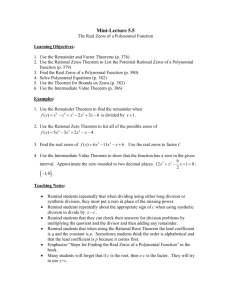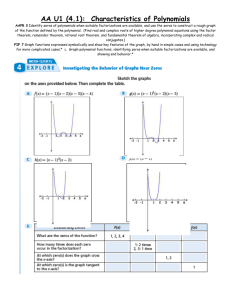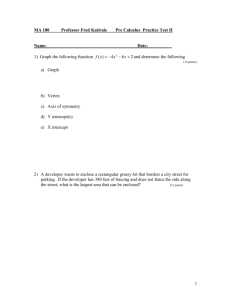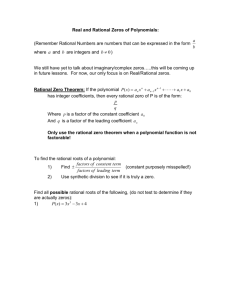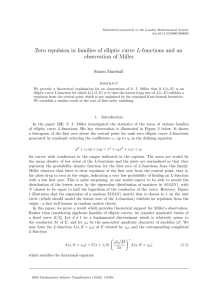U3L7_Intermediate Value Theorem
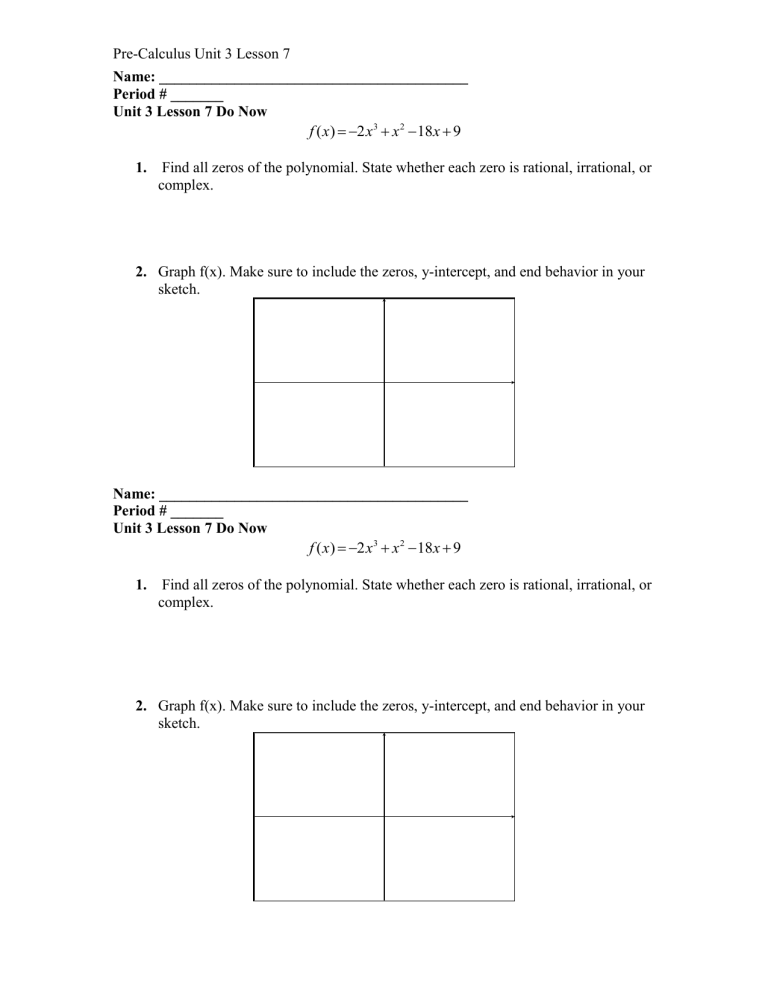
Pre-Calculus Unit 3 Lesson 7
Name: _________________________________________
Period # _______
Unit 3 Lesson 7 Do Now f ( x )
= -
2 x 3
+ x 2
-
18 x
+
9
1.
Find all zeros of the polynomial. State whether each zero is rational, irrational, or complex.
2.
Graph f(x). Make sure to include the zeros, y-intercept, and end behavior in your sketch.
Name: _________________________________________
Period # _______
Unit 3 Lesson 7 Do Now f ( x )
= -
2 x
3 + x
2 -
18 x
+
9
1.
Find all zeros of the polynomial. State whether each zero is rational, irrational, or complex.
2.
Graph f(x). Make sure to include the zeros, y-intercept, and end behavior in your sketch.
Pre-Calculus Unit 3 Lesson 7
Pre-Calculus Honors
Book Reference 2.1 and 2.1
Unit 3 Lesson 7: The Intermediate Value Theorem
Objective: _____________________________________________________
1. Marking Up Text: Mark up the following text on the definition of the intermediate value theorem. Use this reading to complete example #1 and #2 on the back of this handout.
Intermediate Value Theorem
The idea behind the Intermediate Value Theorem is this:
When you have two points connected by a continuous curve:
one point is below the line the other point is above the line then there will be at least one place where the curve intersects the line.
Now that you know the idea , let's look more closely at the details.
Continuous
The curve must be continuous ... no gaps or jumps in it.
When:
The curve is the function f(x), which is continuous on the interval [a, b], and w is a number between f(a) and f(b),
Then there must be at least one value c within [a, b] such that f(c) = w
Notice that:
w is between f(a) and f(b), which leads to ...
c must be between a and b
Pre-Calculus Unit 3 Lesson 7
At Least One
It also says "at least one value c", which means you could have more.
Here, for example, are 3 points where f(x)=w.
Example: Is there a solution to x 5 - 2x 3 - 2 = 0 between x = 0 and x = 2?
At x = 0:
0 5 - 2 × 0 3 - 2 = -2
At x = 2:
2 5 - 2 × 2 3 - 2 = 14
Now we know:
at x = 0, the curve is below zero
at x = 2, the curve is above zero
being a polynomial, the curve will be continuous so somewhere in between, the curve must cross through y = 0
Yes, there is a solution to x 5 - 2x 3 - 2 = 0 in the interval [0, 2]
Pre-Calculus Unit 3 Lesson 7
Example #1:
Verbal Representation
Directions: State whether f(x) has a real zero in the given interval. Show all work and explain using the definition of the intermediate value theorem. f ( x )
x
3
2 x
2 x
4 ; [-3, -2]
Example #2
Verbal Representation
Directions: State whether g(x) has a solution such that g(c) = -1. Show all work and explain using the definition of the intermediate value theorem. f ( x )
= x
5
-
2 x
3
+ x
2
+
2.
Graphical Representation
Directions: Graph the function f(x), and find the value of the real zero, using your graphing calculator. Round your zero to three decimal places.
Graphical Representation
Directions: Graph the function g(x), and find the value where g(c) = -1, using your graphing calculator. Round your zero to three decimal places.
Pre-Calculus Unit 3 Lesson 7
Finding all Zeros of a Polynomial Function Problem Set
(Extra Practice Before Quiz)
1.) Use the remainder theorem to find the remainder when f(x) is divided by (x- k). f ( x )
=
3 x
3 -
2 x
2 + x
-
5;( x
+
2)
2.) Divide f(x) by d(x), using the most appropriate method, and write a summary statement in polynomial form. a.) f ( x )
x
4
3 x
3 x
2
3 x
3 ; d ( x )
x
2 b.) f ( x )
3 x
4
5 x
3
2 x
2
3 x
6 ; d ( x )
3 x
1 c.) f ( x )
2 x
4
3 x
3
9 x
2
14 x
7 ; d ( x )
x
2
4
3.) Use the Rational Zero Theorem to write a list of possible rational zeros. f ( x )
2 x
4 x
3
4 x
x
18
4.) Find all real zeros of the function. Identify each zero as rational or irrational. a.) f ( x )
x
3
6 x
2
7 x
4 b.) f ( x )
x
4
3 x
3
11 x
2
21 x
28 c.) f ( x )
=
2 x
4 +
8 x
3 +
2 x
2 -
16 x
-
12
Homework: Complete Problem Set (Optional) & Study for Quiz on Finding Zeros and Factoring Polynomials.

